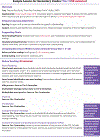Evidence-Based Reading Instruction for Secondary Students With Reading Difficulties Within Multitiered Systems of Support
- PMID: 39145109
- PMCID: PMC11323112
- DOI: 10.1177/00400599221079643
Evidence-Based Reading Instruction for Secondary Students With Reading Difficulties Within Multitiered Systems of Support
Abstract
Christian Scott recently returned home from college and was set to begin his first year as a middle school special education teacher. During his first meeting with his new principal, he learned about his teaching schedule. His principal, Mrs. Walker, explained their district was making a push for using multitiered systems of support (MTSS) as a framework for instruction. Her school would identify students with reading difficulties based on their performance on prior state reading tests and use this information to develop student schedules that allow students to receive additional reading interventions (i.e., Tier 2, Tier 3). Christian would teach reading to students with disabilities on his caseload across instructional tiers (Tiers 1-3). He would be tasked with providing co-teaching support for students with disabilities as they participate in general education classes (i.e., Tier 1). He would also provide additional Tier 2 supports to students with and without disabilities that did not pass the state achievement test in reading. Finally, he would provide intensive interventions to students with disabilities who required small group instruction (Tier 3). Having just received his special education teaching credential, Christian was familiar with the co-teaching service delivery model and the elements of effective instruction for middle school students with reading difficulties. However, he wondered, "What will this actually look like? How will I support the general education teacher providing Tier 1 supports? It sounds like I will also provide Tier 2-type instruction to students via a reading intervention class. What should this look like? How will this differ from the small group, Tier 3 instruction I need to provide?" Christian's mind raced with questions he was too nervous to ask in his first meeting with his new supervisor. The special education lead teacher noticed Christian seemed unsure how to respond. She jumped in, "Don't worry, Christian. School doesn't start for a few weeks. I'll help you with the details so you can hit the ground running." Christian felt excited about the challenge but also overwhelmed. Planning lessons for students with varying needs across instructional tiers was a tall order, and he felt unsure about how to get started.
Conflict of interest statement
DECLARATION OF CONFLICTING INTERESTS The author(s) declared no potential conflicts of interest with respect to the research, authorship, and/or publication of this article.
Figures









References
-
- Annamma S, Eppolito A, Klingner J, Boele A, Boardman A, & Stillman-Spisak SJ (2011). Collaborative strategic reading: Fostering success for all. Voices from the Middle, 19(2), 27–32.
-
- Archer AL, Gleason MM, & Vachon VL (2003). Decoding and fluency: Foundation skills for struggling older readers. Learning Disability Quarterly, 26(2), 89–101. 10.2307/1593592 - DOI
-
- Archer AL, & Hughes CA (2010). Explicit instruction: Effective and efficient teaching. Guilford Press.
-
- Baumann JF, Edwards EC, Boland EM, Olejnik S, & Kame’enui EJ (2003). Vocabulary tricks: Effects of instruction in morphology and context on fifth-grade students’ ability to derive and infer word meanings. American Educational Research Journal, 40(2), 447–494.
-
- Bhattacharya A, & Ehri LC (2004). Graphosyllabic analysis helps adolescent struggling readers read and spell words. Journal of Learning Disabilities, 37(4), 331–348. - PubMed
Grants and funding
LinkOut - more resources
Full Text Sources
